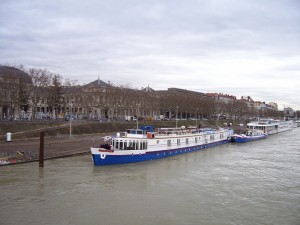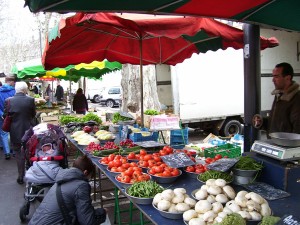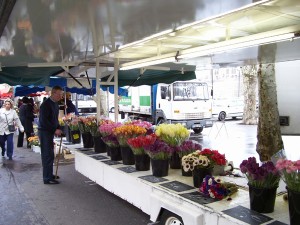THE RIVERS OF FRANCE – LYON BY FOOT
THE RIVERS OF FRANCE
This is the seventh in a series of articles about a boat trip along the Rhone River
LYON BY FOOT
By Charles N. Stevens
Photos by Dolores Seidman
Drizzle drifts down out of a low gray sky this morning, the Rhone murky and dull as we look at it through our porthole. Across the river, barges are docked against the bank, cars whizzing by on the street above them. Naked sycamores partially hide rows of apartments with typical mansard roofs and multiple chimneys. The scene looks very “French.”
We walk over the University Bridge that spans the Rhone, still a wisp of mist in the air. Once across we brave the crowds on a walking street closed to traffic. But it seems that a car or a truck delivering goods often blocks the way, making people walk around them. At the end of this street is Bellecour Square where we walked the day before. There is no sign of yesterday’s demonstrations, the banner draped over the green-stained statue of Louis XIV now removed. The square is a vast area paved over with something like reddish cement. Many people pass through the square, a number of them heading for the Metro station at its edge. In a clear space among the crowd a little boy plays soccer with his grandfather, both awkwardly kicking a small green ball.
Moving on, we approach the outdoor market set up along the banks of the Saone River. Colorful and attractive, it extends for over a block. Offered are fruits, vegetables, cheeses, meats, fish and flowers. We wander slowly through the stalls enjoying displays of white asparagus, bunches of radishes arranged to look like red and white bouquets, long white radishes, avocados, tightly closed artichokes, dried figs, honey, olive oil, tempting lettuces and banana squashes with thick orange meat.
Leaving the market, we cross the bridge over the Saone Inflatable Water Slide to the older part of town. We amble along cobbled streets peering into the sparkling clean shop windows. I especially like the bakery windows, the loaves of all types of breads artistically arranged. In another bakery window I admire the pies, some of them shallow discs with crimped crust edges, the fruit on top glazed and glistening. I entertain a fantasy of living here, buying my food at the open markets and baking goods at the charcouterie then preparing fabulous meals in my apartment.
We read the menus outside of restaurants as is our habit, learning more about what is offered in a typical French restaurant. We blink at the expensive prices. Having all meals prepared on our ship we are not looking for a place to eat, our investigations only research. .
We enter St. Jeans Cathedral where we had been yesterday. The church is dark and cool inside, but the stained glass is colorful, especially a round window with ruby-colored glass. Most interesting is the 16th century astronomical clock standing at least fifteen feet high. Signs of the Zodiac are spaced around the circular clock face, the center being a golden sunburst. Figures are in niches on top. Many people have gathered in front of the clock because it is almost noon when the ancient time piece springs into action. Precisely at twelve noon music flows out of the antique clock, and the figures begin their mechanical marches, followed by the chiming of the hour. Once the spectacular show is over, the crowd disperses.
After lunch on the ship Dolores and I walk to the French Resistance Museum not far away. It is housed in the same building occupied by the German SS during World War II. It is also the same building where Klaus Barbie, the notorious Nazi SS officer was tried for his crimes. Captured in Bolivia he was sent back to stand trial. We learned a lot at the museum. I did not know that the Nazi-sympathizing Vichey Government under Marshall Petain also rounded up Jews, Gypsies, Communists, members of secret societies such as the Masons and homosexuals, sending trainloads of them to concentration camps in Germany. Going through this museum is sobering as it reminds us of the potential for mans’ inhumanity to man. Could it ever happen again?
At night Dolores and I walk out on the closest bridge to our ship. At about the center of it we stop and lean on the concrete railing to gaze at the view. The bridges and buildings are lit up at night providing a magnificent scene of twinkling lights, flood-lit monuments, neon and the busy headlights of cars. A cold wind blows along the Rhone carrying the fresh scent of the river. We zip up our jackets against the chill, but the view is fantastic, and we don’t want to leave.

Our boat, our home for the tour, remains docked in Lyon.

Colorful outdoor markets along the Saone River are exciting to visit.

Fragrant flowers of many kinds are offered at the same market.




Very good!! The food made me hungry…. And did not realize that the Viochy government was so involved with the Nazi atrocities.